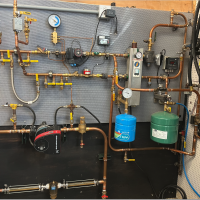Best Of
Re: Ways to Tamper-Proof 4" Outside Sewerline cleanout cap
Teenagers & drunkards outside the pubs will try to kick pipes off the wall, but aren't Hellbent on sabotaging your sewer line . Can you show us a picture? Mad Dog
Re: Ways to Tamper-Proof 4" Outside Sewerline cleanout cap
If you post a Picture of the actual location & trafficked area, we can give you the best option. Mad Dog
Re: Ways to Tamper-Proof 4" Outside Sewerline cleanout cap
One of these should fit your needs. They can be found on SupplyHouse.com
 Intplm.
Intplm.
Re: Ways to Tamper-Proof 4" Outside Sewerline cleanout cap
Would your would-be-tamperers have a wrench with them?
What is the thing that you fear they are going to try to do?
Re: LNG export increases impact on natural gas’s use for heating in US
It's worth looking at how spot gas prices (and as a result electricity prices) have fluctuated over the last few years in Europe and the UK. Funny how supply and demand works…
Re: LNG export increases impact on natural gas’s use for heating in US
ha that’s pretty dramatic - Nat Gas is the predominant heating and electricity source. We can use it.
Re: Mod Con broken down to the basics
Better off not using the checks installed in the circs.
What works in the lab doesn't always transfer to the field.
Re: Super hot mini boiler no power
OK if there is 120 VAC across L1 and L2 and no 24 VAC, if you have not, I would also check the 5 Amp fuse to the left of the transformer (the big thing in the middle of the board). It is defined as a 'Pump Fuse' on the schematic, however it is not shown on the ladder diagram, so I have little confidence of its placement in the circuit.
I would double check all measurements.
Other than the fuse with the symptoms of 120 VAC across L1 and L2 and no 24 VAC on the other connector the most likely cause is the transformer failed, or a failed solder connection(s) on the circuit board could also cause this symptom. The board would have to be removed to inspect the solder joints for cracks also.
With the ohmmeter function of the multimeter and the system power OFF (circuit breaker OFF), I would verify the continuity of the primary and secondary of the transformer, some things may have to be disconnected and/or the board removed to get an accurate reading of the transformer.
It is possible to replace the transformer if a suitable replacement one can be found, also failed solder joints can be re-soldered. I suspect that whole board is proprietary to the boiler manufacture, so if replacement of the board is the best remedy for you, you may have to contact the manufacture or their parts distributor.
Just saying; If it was my boiler and it is a failed transformer and I could not find a suitable replacement of the circuit board mounted transformer. I would remove the failed transformer and connect up a generic 120 VAC to 24 VAC transformer and mount it elsewhere in a safe place. I can easily do that type of repair, also I realize others can't or are not comfortable doing so. I suspect a typical HVAC pro may not be comfortable with that type of repair, they would want to replace the board or the whole boiler if the board is not available any more.
Re: Testing a Taco i100C3R-1 Mixing Valve? -- SOLVED
If a lot of rust or sludge came out of the air sep, you might split it open and check the media. It is not uncommon to see them badly sludged in some systems. Non barrier pex or other radiant tube, for example.
When they plug this badly you need to use a nylon brush. Or replace the media.
This is not the seps fault, but a water quality issue.
 hot_rod
hot_rod
Re: Testing a Taco i100C3R-1 Mixing Valve? -- SOLVED
Solved: appears to have been sludge in a pipe.* Also the make-up water pipe, which was plumbed into the bottom of the Spirovent with no clean out, was plugged with rust.
A useful technique: with the system turned off, close valves to isolate the flow to a single path. Open a drain (into a 5 gallon bucket; a short hose used ONLY for this (as it will have traces of sludge) is helpful) and open the drain until sludge stops coming out.
May be less confusing to shut off the make-up water feed first, and count on the pressure accumulator for flow. Refill the accumulator as needed.
If there are multiple flow paths (if you don't close valves), water will pass through the non-clogged pipes, go around any clogs, and not push the sludge out of any clogged pipes.
* Always hard to tell exactly what happened inside a system of opaque pipes. But sludge came out, and it started working after this.






